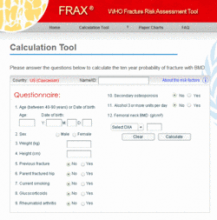New federal recommendations on screening for osteoporosis provide more detail on when to screen women younger than age 65 years and – for the first time – point to a lack of data for screening decisions in men.
The U.S. Preventive Services Task Force updated its 2002 recommendations on osteoporosis screening to call for routine screening in all women aged 65 years or older and in any younger women whose fracture risk is equal to or greater than that of a 65-year-old white woman who has no additional risk factors (equivalent to a 9.3% or greater risk of fracture within 10 years). Previously, women younger than 65 years would be screened if they were at least 60 years old with risk factors for fracture.
The new recommendations were posted on the USPSTF Web site and published online by the Annals of Internal Medicine on Jan. 18.
For the first time, the USPSTF evaluated the evidence for osteoporosis screening in men and found insufficient evidence to form any recommendation, Dr. Ned Colange, chair of the USPSTF, said in an interview. There’s not enough evidence to recommend osteoporosis screening or treatment in men with no prior osteoporotic fractures, and "there’s certainly not enough evidence to say, ‘Don’t’ do it," he said.
"While there’s not a call to action, that’s an important call for research," added Dr. Colange, who is president and CEO of the Colorado Trust Foundation, Denver.
In women, the recommendations do not say to stop osteoporosis screening at any specific age because the risk of fractures continues to increase with advancing age, and the minimal potential harms of treatment remain small. Clinicians who are considering treating older patients with significant morbidity should take into account data showing that the benefits of osteoporosis treatment emerge 18-24 months after starting treatment.
To predict an individual’s risk for osteoporotic fracture, the USPSTF used the online FRAX tool, developed by the World Health Organization and the National Osteoporosis Foundation.
"The nice thing about the FRAX calculator is, the patient herself can determine that risk. It’s available online. It uses measures that the woman should know," Dr. Colange said. "The clinician can do it, but the patient herself could do it as well."
The FRAX tool estimates 10-year fracture risk based on easily obtained information such as age, body mass index (BMI), parental fracture history, and tobacco or alcohol use. It asks about results of dual-energy x-ray absorptiometry scans but does not require this information to calculate fracture risk.
Younger women can reach the new threshold for screening because of various risk factors. For example, a white woman would qualify for screening if she is 50 years old, smokes, drinks alcohol daily, has a BMI less than 21, and has a parental history of fracture. A 55-year-old white woman would need only a parental fracture history to warrant osteoporosis screening. A 60-year-old white woman who smokes and drinks alcohol daily would fit the 10-year-risk profile for screening (Ann. Intern. Med. 2011 Jan 18 [doi:]).
White women are more likely than women of other races or ethnic backgrounds to develop osteoporosis and fractures. Although there are fewer data on nonwhite women, the USPSTF recommended screening all women at age 65 years because the consequences of failing to identify and treat low bone-mineral density are considerable, the potential risks of treatment are small, and it’s unclear if there’s a better strategy for screening nonwhite women.
There are not enough data to recommend when to rescreen women without osteoporosis on their initial screen, the USPSTF stated, but at least a 2-year interval would be needed to assess a change in bone density and perhaps longer for better prediction of fracture risk.
The new recommendations are based on a 2010 review of studies published since 2002 by a team at the University of Oregon Health and Science University’s Evidence-Based Practice Center in Portland.
An estimated 12 million Americans aged 50 years or older will have osteoporosis in 2012. Among postmenopausal women, 15% will develop a hip fracture during their lifetime, 25% will develop a vertebral deformity, and osteoporotic fractures of any kind will affect 50%.


